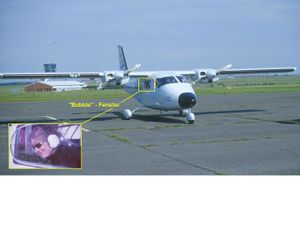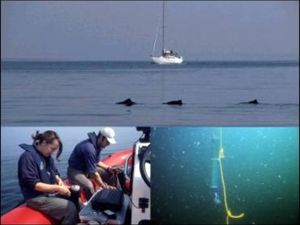Difference between revisions of "Acoustic monitoring of marine mammals"
Cliviahaese (talk | contribs) m |
Cliviahaese (talk | contribs) m |
||
| Line 1: | Line 1: | ||
| − | |||
[[image:lucke1.jpg|thumb|right|A typical airplane (Partenavia 68) used for surveys with high wings and bubble windows allowing a good view onto the track line under the plane. (Picture: FTZ Westküste)]] | [[image:lucke1.jpg|thumb|right|A typical airplane (Partenavia 68) used for surveys with high wings and bubble windows allowing a good view onto the track line under the plane. (Picture: FTZ Westküste)]] | ||
| Line 6: | Line 5: | ||
The abundance and distribution of marine mammals can best be assessed by applying line transect distance sampling methods and analysis techniques (e.g. [http://www.ruwpa.st-and.ac.uk/distance/]) on data gathered from either visual observation above the surface (land-based from an elevated point on the shore, ship-based or from an airplane) or by using acoustic detectors underwater. | The abundance and distribution of marine mammals can best be assessed by applying line transect distance sampling methods and analysis techniques (e.g. [http://www.ruwpa.st-and.ac.uk/distance/]) on data gathered from either visual observation above the surface (land-based from an elevated point on the shore, ship-based or from an airplane) or by using acoustic detectors underwater. | ||
| + | |||
| + | [[image:lucke2.jpg|thumb|right|Harbour porpoises sighting from a sailing boat and deplyment of a T-POD underwater to detect their presence by monitoring their acoustic emissions. (Picture: Harald Benke, Deutsches Meeresmuseum)]] | ||
The detection of sounds emitted underwater by the marine mammals is done by using hydrophones (e.g. [http://www.unipv.it/webcib/edu_underwaterbioacoustics_uk.html#sdet]). Usually two or more hydrophones are being towed in an array as the time difference of arrival of the individual sounds at the spatially separated hydrophones allows to triangulate and analyse for bearing of the received sound and thereby to locate the sound source. | The detection of sounds emitted underwater by the marine mammals is done by using hydrophones (e.g. [http://www.unipv.it/webcib/edu_underwaterbioacoustics_uk.html#sdet]). Usually two or more hydrophones are being towed in an array as the time difference of arrival of the individual sounds at the spatially separated hydrophones allows to triangulate and analyse for bearing of the received sound and thereby to locate the sound source. | ||
| − | |||
| − | |||
The acoustic sensitivity of the receiver and the width of the hydrophones frequency spectrum in relation to the ambient noise define the detection range of the hydrophones and the variety of marine mammals that be detected with it. The receiving hydrophones are either being towed behind a vessel ([http://www.unipv.it/webcib/edu_underwaterbioacoustics_uk.html]) or deployed as stationary hydrophones (SOSUS: | The acoustic sensitivity of the receiver and the width of the hydrophones frequency spectrum in relation to the ambient noise define the detection range of the hydrophones and the variety of marine mammals that be detected with it. The receiving hydrophones are either being towed behind a vessel ([http://www.unipv.it/webcib/edu_underwaterbioacoustics_uk.html]) or deployed as stationary hydrophones (SOSUS: | ||
Revision as of 16:47, 14 May 2007
Amongst the marine mammals especially the members of the two orders Pinnipedia (seals) and Cetacea (whales) have evolved an acute sense of hearing and use sound also for communication purposes. Moreover numerous toothed whale species are also capable of using echolocation to detect and characterise their food, navigate in their under water environment and to avoid obstacles. The transmission of sound is the most efficient form of information transfer underwater both for the animals to communicate and orient in their underwater environment but also for us to detect and localise the animals themselves by using active and passive acoustic detection methods. The acoustic characteristics of the sound emissions of marine mammals can differ considerably, ranging from very short pulsed echolocation clicks to long lasting frequency modulated songs (e.g. [1]). Due to their mainly submerged lifestyle it is difficult to assess the movements and habitat use of whales and seals. To monitor their movements as well as their abundance and density in a selected area over time it is important to chose the appropriate methods.
The abundance and distribution of marine mammals can best be assessed by applying line transect distance sampling methods and analysis techniques (e.g. [2]) on data gathered from either visual observation above the surface (land-based from an elevated point on the shore, ship-based or from an airplane) or by using acoustic detectors underwater.
The detection of sounds emitted underwater by the marine mammals is done by using hydrophones (e.g. [3]). Usually two or more hydrophones are being towed in an array as the time difference of arrival of the individual sounds at the spatially separated hydrophones allows to triangulate and analyse for bearing of the received sound and thereby to locate the sound source.
The acoustic sensitivity of the receiver and the width of the hydrophones frequency spectrum in relation to the ambient noise define the detection range of the hydrophones and the variety of marine mammals that be detected with it. The receiving hydrophones are either being towed behind a vessel ([4]) or deployed as stationary hydrophones (SOSUS: [5] [6], T-PODs: [7][8]). Usually a specialised sound recognition software is needed to identify to which species the recorded sounds can be attributed to.
With decreasing size of the technical acoustic components it is possible to deploy sound recording systems on the marine mammals to monitor their acoustic emissions simultaneously to the sound immissions received by them. In combination with satellite tags and data loggers (D-tag: [9], A-tag: [10]) this new approach allows to follow the animals movements and to analyse its behaviour in relation to environmental parameters in retrospect using dead reckoning methods ([11]).

